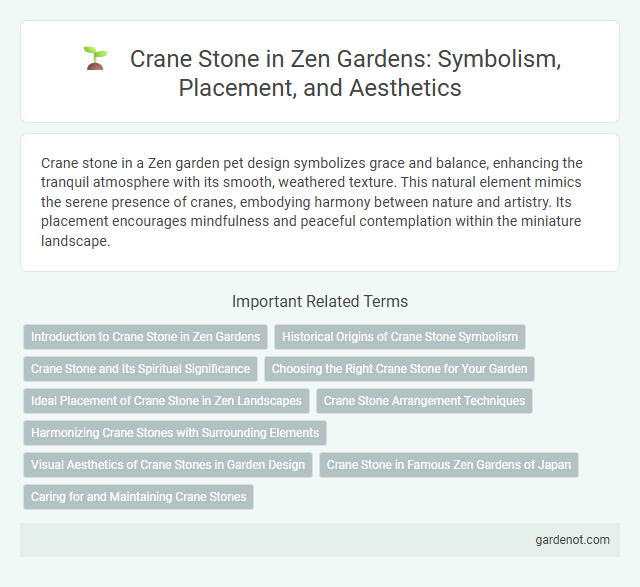Crane stone in a Zen garden pet design symbolizes grace and balance, enhancing the tranquil atmosphere with its smooth, weathered texture. This natural element mimics the serene presence of cranes, embodying harmony between nature and artistry. Its placement encourages mindfulness and peaceful contemplation within the miniature landscape.
Introduction to Crane Stone in Zen Gardens
Crane stone, or "tsuru-ishi," is a symbolic rock placement in Zen gardens representing longevity and good fortune, inspired by the crane bird revered in Japanese culture. Typically, this polished stone is set upright or slightly tilted, evoking the crane's graceful posture amidst the garden's minimalist design. Its presence enhances the garden's spiritual ambiance, promoting meditation and connection to nature's harmony.
Historical Origins of Crane Stone Symbolism
Crane stones, traditionally used in Zen gardens, symbolize longevity and transcendence, rooted deeply in East Asian cultural history. Their irregular shapes resemble the silhouette of cranes, a bird revered in Chinese and Japanese folklore as a spiritual messenger and an emblem of good fortune. This symbolism reflects Zen Buddhism's emphasis on natural simplicity and the meditative essence found within garden landscapes.
Crane Stone and Its Spiritual Significance
Crane Stone, a smooth, weathered rock often found in Zen gardens, symbolizes longevity and spiritual awakening, reflecting the crane's association with immortality in Japanese culture. This stone's presence encourages meditation and mindfulness, fostering a deep connection between nature and inner peace. Its deliberate placement enhances the garden's harmony, inviting contemplation on life's serene and enduring qualities.
Choosing the Right Crane Stone for Your Garden
Selecting the right crane stone for your Zen garden involves considering size, shape, and texture to harmonize with the surrounding elements. Opt for a stone with natural curves and a smooth surface that evokes tranquility while symbolizing longevity and good fortune. Placement should create balance within the garden's layout, enhancing the overall aesthetic and spiritual ambiance.
Ideal Placement of Crane Stone in Zen Landscapes
The ideal placement of a Crane stone in Zen landscapes is near the water element to symbolize longevity and grace. Positioning it atop a gentle slope or beside a cluster of smaller stones enhances the visual balance and evokes natural mountain imagery. Ensuring that the stone's contours face the viewer creates a focal point that encourages meditation and mindfulness.
Crane Stone Arrangement Techniques
Crane stone arrangement techniques in Zen gardens emphasize the symbolic placement of tall, slender stones resembling cranes to evoke tranquility and balance. These stones are strategically positioned to create a sense of natural harmony, often accompanied by smaller rocks and sand patterns that mimic water ripples. Mastery of crane stone placement enhances the garden's contemplative atmosphere, reflecting traditional Japanese aesthetics.
Harmonizing Crane Stones with Surrounding Elements
Crane stones, prized in Zen gardens for their natural elegance and irregular forms, harmonize seamlessly with surrounding elements by echoing the organic shapes of plants and water features. Their weathered textures and unique silhouettes create focal points that balance the garden's minimalist aesthetic and evoke a sense of timeless tranquility. Positioning crane stones near moss beds or bamboo groves enhances visual cohesion, fostering a meditative ambiance that reflects traditional Japanese design principles.
Visual Aesthetics of Crane Stones in Garden Design
Crane stones serve as striking focal points in Zen garden design, their irregular shapes and natural textures emulating the graceful form of a crane. The visual aesthetics of these stones enhance the garden's harmony, creating balance through asymmetry and evoking a sense of dynamic tranquility. Positioned thoughtfully among moss and raked gravel, crane stones contribute to the garden's meditative ambiance and artistic elegance.
Crane Stone in Famous Zen Gardens of Japan
Crane Stone, known as Tsuru-ishi, is a prominent feature in many famous Zen gardens across Japan, symbolizing longevity and good fortune. This natural stone formation often resembles a crane with outstretched wings and is carefully positioned to enhance the garden's harmony and spiritual atmosphere. Notable Zen gardens such as those at Ryoan-ji Temple and Kenroku-en prominently display Crane Stones, blending natural beauty with profound cultural symbolism.
Caring for and Maintaining Crane Stones
Crane stones require regular cleaning to prevent algae and moss buildup, which can obscure their natural patterns and texture in a Zen garden. Gently rinse with water and use a soft brush to remove debris without damaging the stone's surface. Positioning crane stones in areas with moderate shade helps maintain their coloration and reduces weathering effects.
Crane stone Infographic

 gardenot.com
gardenot.com